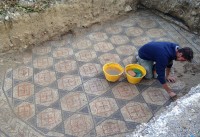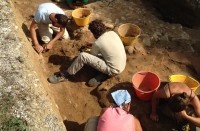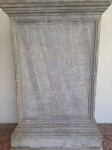 Archaeologists have discovered the ruins of a grand Roman villa outside of Florence. The luxury home was unearthed on private property in what is now the village of Capraia by archaeologists and students from the University of Pisa. So far the team has found a hexagonal structure with six rooms which they believe to include a dining room suite with multiple triclinia. It is of monumental scale, 100 feet in diameter with ceilings estimated to be 50 feet high. Multiple polychrome mosaic floors survive, including a scene of a wild boar hunt in the main reception area. They have also found the remains of the hypocaust system that heated the villa’s baths, namely the hollow space under the floor with pillars of tile (pilae stacks) that supported the floor of the hot room.
Archaeologists have discovered the ruins of a grand Roman villa outside of Florence. The luxury home was unearthed on private property in what is now the village of Capraia by archaeologists and students from the University of Pisa. So far the team has found a hexagonal structure with six rooms which they believe to include a dining room suite with multiple triclinia. It is of monumental scale, 100 feet in diameter with ceilings estimated to be 50 feet high. Multiple polychrome mosaic floors survive, including a scene of a wild boar hunt in the main reception area. They have also found the remains of the hypocaust system that heated the villa’s baths, namely the hollow space under the floor with pillars of tile (pilae stacks) that supported the floor of the hot room.
The villa dates to the 4th century A.D. and is an exceptional example of a late antiquity country estate. The size and complexity of the villa is so impressive that dig leader Professor Federico Cantini believes the only comparable aristocratic villas from that period are found in Constantinople, then still just a few decades into its tenure as the new capital of the Roman Empire. The mansion was enlarged in the 5th century only to be plundered and abandoned in the 6th. There is also some evidence of occupation in the late Middle Ages, probably by people who were stripping what was left of it for building materials.
 An inscription on a stone slab found at the villa identifies the owner as Vettius Agorius Praetextatus, a well-known and highly esteemed 4th century senator who had a distinguished political career and who was at the epicenter of the last significant attempt by the few remaining non-Christian members of the aristocratic ruling class to preserve traditional Roman religions in the face of the onslaught of legislation and Christianization practices that would destroy them. Praetextatus held high political and religious office. He was governor of Tuscany and Umbria, consular of Lusitania, proconsul of Achaia, urban praetor, praetorian prefect to Emperor Valentinian II and consul-elect (he died before he could take office). His many religious titles and priesthoods included augur, quindecimvir (guardian of the Sibylline Books), pontifex Vestae, pontifex Solis, sacratus Libero et Eleusinis and curialis Herculis.
An inscription on a stone slab found at the villa identifies the owner as Vettius Agorius Praetextatus, a well-known and highly esteemed 4th century senator who had a distinguished political career and who was at the epicenter of the last significant attempt by the few remaining non-Christian members of the aristocratic ruling class to preserve traditional Roman religions in the face of the onslaught of legislation and Christianization practices that would destroy them. Praetextatus held high political and religious office. He was governor of Tuscany and Umbria, consular of Lusitania, proconsul of Achaia, urban praetor, praetorian prefect to Emperor Valentinian II and consul-elect (he died before he could take office). His many religious titles and priesthoods included augur, quindecimvir (guardian of the Sibylline Books), pontifex Vestae, pontifex Solis, sacratus Libero et Eleusinis and curialis Herculis.
He and his close friend and senatorial colleague Quintus Aurelius Symmachus, who was a very wealthy scion of the patrician Aurelian family and who was known to have at least a dozen country villas of his own, worked together to restore the traditional Roman religions. When he was urban praetor, Praetextatus petitioned the emperor for the restoration of sacred objects looted from temples. When he got the go-ahead, he assigned the job of collecting whatever was left to Symmachus. In 384 A.D., Symmachus wrote an open letter to Valentinian II asking for the return of the Altar of Victory to the Curia, a letter which is still famous today, mainly in conjunction with the equally famous rebuttal written by Ambrose of Milan.
 Later that year, Praetextatus died. The city plunged into public mourning and there was an outpouring of grief from Romans of all religions. His wife of 40 years, Aconia Fabia Paulina, had her eulogy for him, apparently a version of her funeral oration, inscribed on his funerary monument. She shared his religious convictions and held many religious honors herself, and in the oration she said he was now in the heavens where, gods willing, she would soon join him. And she did.
Later that year, Praetextatus died. The city plunged into public mourning and there was an outpouring of grief from Romans of all religions. His wife of 40 years, Aconia Fabia Paulina, had her eulogy for him, apparently a version of her funeral oration, inscribed on his funerary monument. She shared his religious convictions and held many religious honors herself, and in the oration she said he was now in the heavens where, gods willing, she would soon join him. And she did.
Saint Jerome used Praetextatus, whose death had so roiled the city, as an example of how the most exalted, respected pagan will spend eternity in sulfurous agony while the most miserable, derided, self-abnegating Christian will be raised to glory in the hereafter. From his Letter XXIII to Marcella written in 384 A.D., the year of Praetextatus’ death:
Now, therefore, in return for her short toil, Lea enjoys everlasting felicity; she is welcomed into the choirs of the angels; she is comforted in Abraham’s bosom. And, as once the beggar Lazarus saw the rich man, for all his purple, lying in torment, so does Lea see the consul, not now in his triumphal robe but clothed in mourning, and asking for a drop of water from her little finger. How great a change have we here! A few days ago the highest dignitaries of the city walked before him as he ascended the ramparts of the capitol like a general celebrating a triumph; the Roman people leapt up to welcome and applaud him, and at the news of his death the whole city was moved. Now he is desolate and naked, a prisoner in the foulest darkness, and not, as his unhappy wife falsely asserts, set in the royal abode of the Milky Way. On the other hand Lea, who was always shut up in her one closet, who seemed poor and of little worth, and whose life was accounted madness, now follows Christ and sings, “Like as we have heard, so have we seen in the city of our God.”
We know that Praetextatus and Paulina had two houses in Rome, one on the Esquiline whose vast gardens reached what is now Termini railway station and one on the Aventine. Now we know they had a huge country palace in Tuscany. The excavation will be open to the public this weekend, on Saturday afternoon from 3:30 to 6:30 PM, and Sunday from 9:30 AM to 6:30 PM. Professor Cantini and the University of Pisa team will be present to explain the site to visitors.
Wow! I had not heard a word of this–although I live in Florence and consider myself an archeology buff. But while technically in the province of Florence, Capraia e Limite is on the periphery of Empoli which seems very far away. An amazing site and only a few minutes from Vinci with its mostly bogus Leonardo Museum.
You should go to the open house this weekend! I would absolutely love to hear your eye-witness testimony.
The Altar of Victory makes a fascinating story, particularly as synecdoche for the Roman religious question in the 4th century.
The Altar, after a long and stable history, suddenly began to gyrate. Removed in 357 and replaced in the same year, the altar once again left the Senate in 382. A public, decade-long debate ensued and it was briefly replaced during the reign of Eugenius (392-394).
However, the Altar of Victory then simply vanishes under Theodosius. No record survives of what happened to it or where it rests. That’s probably as the Christian party wanted it.
I harbour an almost certainly vain hope that someone rescued it and buried it for its own protection like they did the bronzes of the Boxer at Rest and the Hellenistic Prince.
Can anyone recommend a good book on the persecution of the pagans by the Roman Christians?
The Last Pagans of Rome is excellent. Solid scholarship very thoroughly annotated but still highly readable and engaging.
I don’t know offhand of any non-fiction, but Gore Vidal’s novel about Julian the Apostate (JULIAN) was a wonderful non-Christian (anti really) take on this period.
I love that book! I think the epistolary genre is underused in general, and Vidal does a masterful job of using it to immerse you in the polytheist perspective of events.
You might find this, in combination with that, helpful – where e.g. this is referred to, and here for the action under Theodosius as described here and here.
Another incredible chapter to add to the continuing rediscovery of the Ancient Classical world. I never cease to be amazed by the never ending efforts of those who spend their entire lives in the pursuit of searching for and rescuing from the world’s earth the treasures of the distant past- in particular, the periods of Classical Greece and Rome.
What a distant gap lies between the sorry characters/posers of today who pass as our supposed political “Leaders” to the immortal giants of Classical times whose words have by some great miracle survived and come down to us.
I have recently discovered in a distant land a centuries old copy of THE MEDITATIONS OF THE EMPEROR MARCUS AURELIUS ANTONINUS which I plan to have rebound in finest leather in a manner befitting its unique intellectual contents.
Perhaps for me one of the most outstanding achievements of rescuing the Classical Past was the discovery the sublime statue, LAOCOON, discovered in the time of Michelangelo who rushed to see it just after it was released from the bonds of the Earth and was astonished by its incomparable power and beauty. The LAOCOON will forever remain for me one of the greatest, if not the greatest, marble sculptures of the Ancient world. One gazes upon it in silent awe.
We are certainly much indebted to people like dig leader Professor Federico Cantini who is expending so much effort regarding the safeguarding of the newly discovered ancient villa identified as being owned by the Senator, Vettius Agorius Praetextatus.
We can only imagine what other magnificent long buried treasures of the Classical World yet remain to be discovered, waiting to see the light of day.
Thank you for sharing this very special story.
Amazing how fast religion appears to have changed during that period. Wasn’t it only in the early 4th century that the persecution of christians was banned by Constantine?
There were periods of toleration before then, but the first edict that officially legalized Christianity was promulgated by Galerius in 311, followed two years later by the Edict of Milan under Constantine. So yes, the 4th century saw a dramatic shift in religious attitudes.
I find it remarkable the floor mosaic design depicts a cross in the middle of each square within the hexagons; unusual for a pagan household, I would think. Surely there was no intention to honor Christianity, given the Senator’s belief system.
I was curious about that as well. It’s possible that particular mosaic was part of the expansion of the villa in the 5th century. The photographs didn’t come with detailed captions, I’m afraid.
Thanks for the suggestions.
I don’t believe that the red cross design in the middle of the tiles is a Christian cross, as the design is symmetrical on all four arms with little cross bits on the ends. But that form of cross has been a prevalent pagan symbol for eons. Also, I didn’t know that Christians persecuted pagans. That is so contrary to Scripture and how a spirit-filled believer should react to persecution. Please accept my regrets and apologies for those in the past who used the name of God for their own means, and for those presently who persist in that delusion.
Sounds like Saint Jérôme would quite happily fit in with ISIS right now!
That would have been more along the above mentioned Ambrose’s bailiwick, Nige. No one could get a persecution going like Ambrose. Jerome was more the dogmatist and translator, the Minister of Propaganda, if you will. He kept the faithful informed and frothing until they could turn the whole shebang over to their successor Augustine to really get things rolling.
Ironically, Augustine was probably still in pagan camp with Symmachus when that floor was laid.
This is a great find!
Slightly off-topic, but I would love to get your (and the commenters) thoughts on this new Netflix series called Roman Empire: Reign of Blood.
Here is a link to the trailer: https://www.youtube.com/watch?v=TDHgU6ixzwk
It’s about Commodus, his reign, and how it sparked the eventual downfall of the Roman Empire.
I didn’t know how else to bring this up other than in the comments section. It would be great to come back to the site in a few days and see a post dedicated to the show itself and what people think of its interpretation of Roman History.
Thanks!